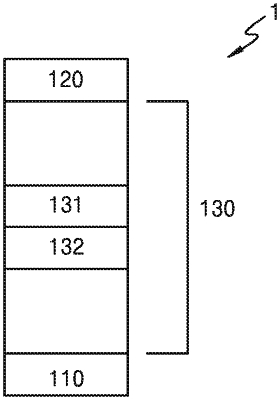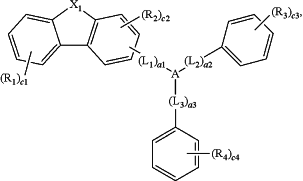| CPC H10K 50/15 (2023.02) [C09K 11/06 (2013.01); H10K 30/865 (2023.02); H10K 50/11 (2023.02); H10K 50/16 (2023.02); H10K 50/171 (2023.02); H10K 50/18 (2023.02); H10K 85/633 (2023.02); H10K 85/6572 (2023.02); H10K 85/6574 (2023.02); C09K 2211/1007 (2013.01); C09K 2211/1018 (2013.01); H10K 2101/10 (2023.02); H10K 2101/90 (2023.02)] | 20 Claims |

|
1. An organic light-emitting device comprising:
an anode;
a cathode;
an organic layer between the anode and the cathode and comprising an emission layer; and
a first exciton quenching layer between the anode and the emission layer and in direct contact with the emission layer,
wherein the emission layer comprises a host and a dopant,
the first exciton quenching layer comprises a first quenching material, and
the host, the dopant, and the first quenching material satisfy Equations 1-1 and 1-2:
T1(Q1)≤T1(H) Equation 1-1
T1(Q1)≤T1(D), and Equation 1-2
wherein, in Equations 1-1 and 1-2,
T1(Q1) indicates a lowest excited triplet energy level of the first quenching material,
T1(H) indicates a lowest excited triplet energy level of the host, and
T1(D) indicates a lowest excited triplet energy level of the dopant,
wherein the first quenching material is represented by Formula 3:
Formula 3
 wherein, in Formula 3,
X1 is N-(L4)a4-(Ar1)b1, O, or S,
A is a substituted or unsubstituted C6-C20 aromatic ring,
R1 to R4 are each independently a group represented by Formula 10, hydrogen, deuterium, —F, —Cl, —Br, —I, a hydroxyl group, a cyano group, a nitro group, an amino group, an amidino group, a hydrazine group, a hydrazone group, a carboxylic acid group or a salt thereof, a sulfonic acid group or a salt thereof, a phosphoric acid group or a salt thereof, a substituted or unsubstituted C1-C60 alkyl group, a substituted or unsubstituted C2-C60 alkenyl group, a substituted or unsubstituted C2-C60 alkynyl group, a substituted or unsubstituted C1-C60 alkoxy group, a substituted or unsubstituted C3-C10 cycloalkyl group, a substituted or unsubstituted C2-C10 heterocycloalkyl group, a substituted or unsubstituted C3-C10 cycloalkenyl group, a substituted or unsubstituted C2-C10 heterocycloalkenyl group, a substituted or unsubstituted C6-C60 aryl group, a substituted or unsubstituted C6-C60 aryloxy group, a substituted or unsubstituted C6-C60 arylthio group, a substituted or unsubstituted C1-C60 heteroaryl group, a substituted or unsubstituted monovalent non-aromatic condensed polycyclic group, a substituted or unsubstituted monovalent non-aromatic condensed heteropolycyclic group, —Si(Q1)(Q2)(Q3), or —B(Q1)(Q2),
Formula 10
 and
wherein, in Formulae 3 and 10,
L1 to L4, L31 and L32 are each independently a substituted or unsubstituted C3-C10 cycloalkylene group, a substituted or unsubstituted C1-C10 heterocycloalkylene group, a substituted or unsubstituted C3-C10 cycloalkenylene group, a substituted or unsubstituted C1-C10 heterocycloalkenylene group, a substituted or unsubstituted C6-C60 arylene group, a substituted or unsubstituted C1-C60 heteroarylene group, a substituted or unsubstituted divalent non-aromatic condensed polycyclic group, or a substituted or unsubstituted divalent non-aromatic condensed heteropolycyclic group,
a1 to a4 and a31 to a32 are each independently 0, 1, 2, or 3,
Ar1, Ar31 and Ar32 are each independently a substituted or unsubstituted C3-C10 cycloalkyl group, a substituted or unsubstituted C1-C10 heterocycloalkyl group, a substituted or unsubstituted C3-C10 cycloalkenyl group, a substituted or unsubstituted C1-C10 heterocycloalkenyl group, a substituted or unsubstituted C6-C60 aryl group, a substituted or unsubstituted C1-C60 heteroaryl group, a substituted or unsubstituted monovalent non-aromatic condensed polycyclic group, or a substituted or unsubstituted monovalent non-aromatic condensed heteropolycyclic group,
b1, b31, and b32 are each independently 1, 2, 3, 4, or 5,
Ar31 and Ar32 are optionally bound to each other to form a saturated or unsaturated ring,
c1 is 1, 2, 3, or 4, c2 is 1, 2, or 3, and c3 and c4 are each independently 1, 2, 3, 4, or 5, and
when c1 is 2 or greater, two of R1(s) are optionally bound to form a saturated or unsaturated ring, when c2 is 2 or greater, two of R2(s) are optionally bound to form a saturated or unsaturated ring, when c3 is 2 or greater, two of R3(s) are optionally bound to form a saturated or unsaturated ring, and when c4 is 2 or greater, two of R4(s) are optionally bound to form a saturated or unsaturated ring, and
Q1 to Q3 are each independently hydrogen, deuterium, —F, —Cl, —Br, —I, a hydroxyl group, a cyano group, a nitro group, an amino group, an amidino group, a hydrazine group, a hydrazone group, a carboxylic acid group or a salt thereof, a sulfonic acid group or a salt thereof, a phosphoric acid group or a salt thereof, a C1-C60 alkyl group, a C2-C60 alkenyl group, a C2-C60 alkynyl group, a C1-C60 alkoxy group, a C3-C10 cycloalkyl group, a C1-C10 heterocycloalkyl group, a C3-C10 cycloalkenyl group, a C1-C10 heterocycloalkenyl group, a C6-C60 aryl group, a C1-C60 heteroaryl group, a monovalent non-aromatic condensed polycyclic group, or a monovalent non-aromatic condensed heteropolycyclic group.
|